Лексикология - ЛЕКЦИЯ 2.pptx
- Количество слайдов: 18
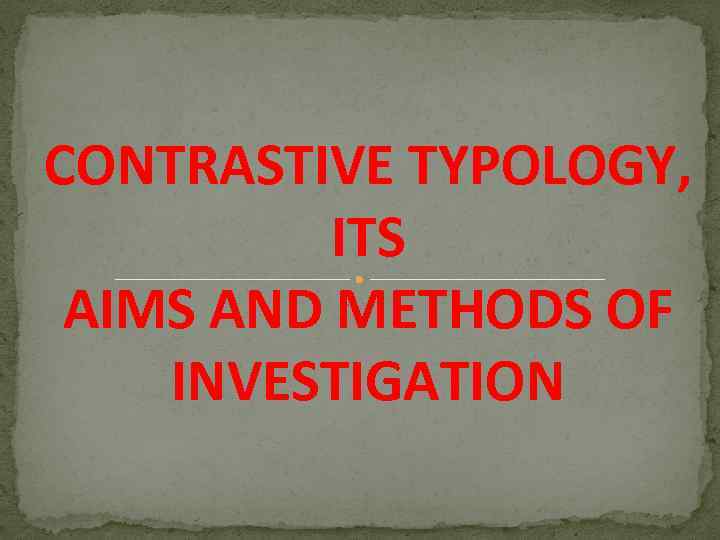 CONTRASTIVE TYPOLOGY, ITS AIMS AND METHODS OF INVESTIGATION
CONTRASTIVE TYPOLOGY, ITS AIMS AND METHODS OF INVESTIGATION
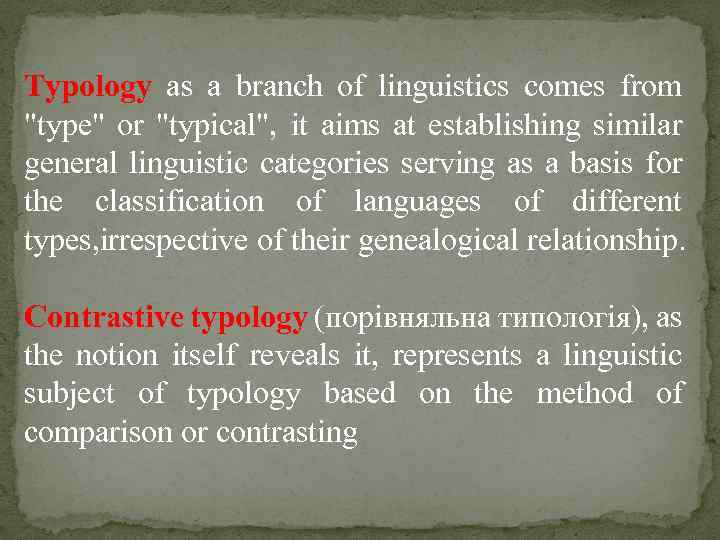 Typology as a branch of linguistics comes from "type" or "typical", it aims at establishing similar general linguistic categories serving as a basis for the classification of languages of different types, irrespective of their genealogical relationship. Contrastive typology (порівняльна типологія), as the notion itself reveals it, represents a linguistic subject of typology based on the method of comparison or contrasting
Typology as a branch of linguistics comes from "type" or "typical", it aims at establishing similar general linguistic categories serving as a basis for the classification of languages of different types, irrespective of their genealogical relationship. Contrastive typology (порівняльна типологія), as the notion itself reveals it, represents a linguistic subject of typology based on the method of comparison or contrasting
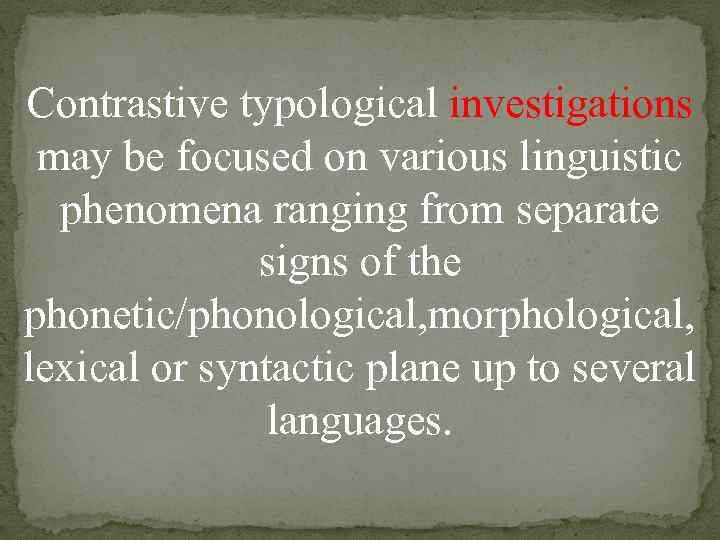 Contrastive typological investigations may be focused on various linguistic phenomena ranging from separate signs of the phonetic/phonological, morphological, lexical or syntactic plane up to several languages.
Contrastive typological investigations may be focused on various linguistic phenomena ranging from separate signs of the phonetic/phonological, morphological, lexical or syntactic plane up to several languages.
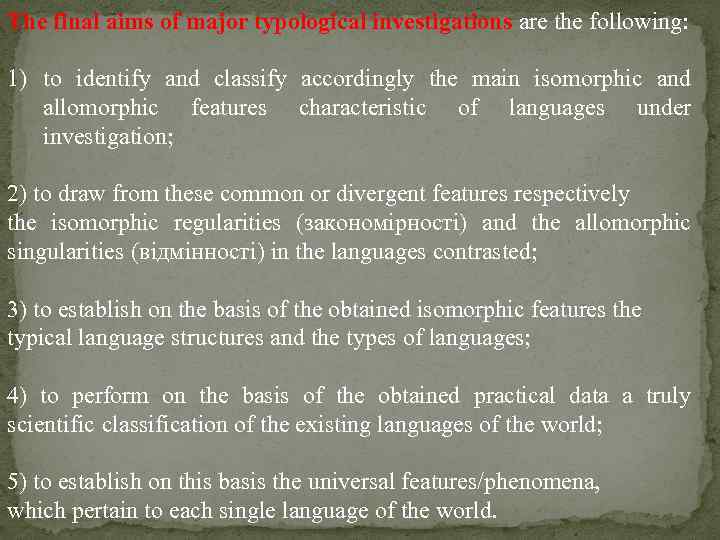 The final aims of major typological investigations are the following: 1) to identify and classify accordingly the main isomorphic and allomorphic features characteristic of languages under investigation; 2) to draw from these common or divergent features respectively the isomorphic regularities (закономірності) and the allomorphic singularities (відмінності) in the languages contrasted; 3) to establish on the basis of the obtained isomorphic features the typical language structures and the types of languages; 4) to perform on the basis of the obtained practical data a truly scientific classification of the existing languages of the world; 5) to establish on this basis the universal features/phenomena, which pertain to each single language of the world.
The final aims of major typological investigations are the following: 1) to identify and classify accordingly the main isomorphic and allomorphic features characteristic of languages under investigation; 2) to draw from these common or divergent features respectively the isomorphic regularities (закономірності) and the allomorphic singularities (відмінності) in the languages contrasted; 3) to establish on the basis of the obtained isomorphic features the typical language structures and the types of languages; 4) to perform on the basis of the obtained practical data a truly scientific classification of the existing languages of the world; 5) to establish on this basis the universal features/phenomena, which pertain to each single language of the world.
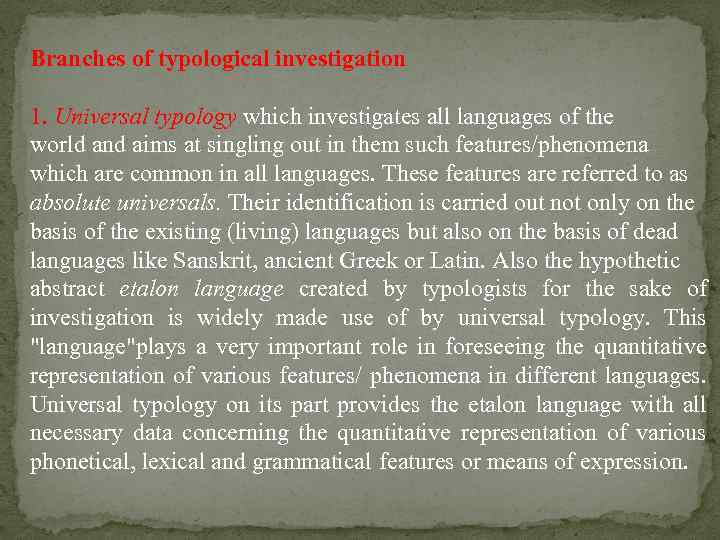 Branches of typological investigation 1. Universal typology which investigates all languages of the world and aims at singling out in them such features/phenomena which are common in all languages. These features are referred to as absolute universals. Their identification is carried out not only on the basis of the existing (living) languages but also on the basis of dead languages like Sanskrit, ancient Greek or Latin. Also the hypothetic abstract etalon language created by typologists for the sake of investigation is widely made use of by universal typology. This "language"plays a very important role in foreseeing the quantitative representation of various features/ phenomena in different languages. Universal typology on its part provides the etalon language with all necessary data concerning the quantitative representation of various phonetical, lexical and grammatical features or means of expression.
Branches of typological investigation 1. Universal typology which investigates all languages of the world and aims at singling out in them such features/phenomena which are common in all languages. These features are referred to as absolute universals. Their identification is carried out not only on the basis of the existing (living) languages but also on the basis of dead languages like Sanskrit, ancient Greek or Latin. Also the hypothetic abstract etalon language created by typologists for the sake of investigation is widely made use of by universal typology. This "language"plays a very important role in foreseeing the quantitative representation of various features/ phenomena in different languages. Universal typology on its part provides the etalon language with all necessary data concerning the quantitative representation of various phonetical, lexical and grammatical features or means of expression.
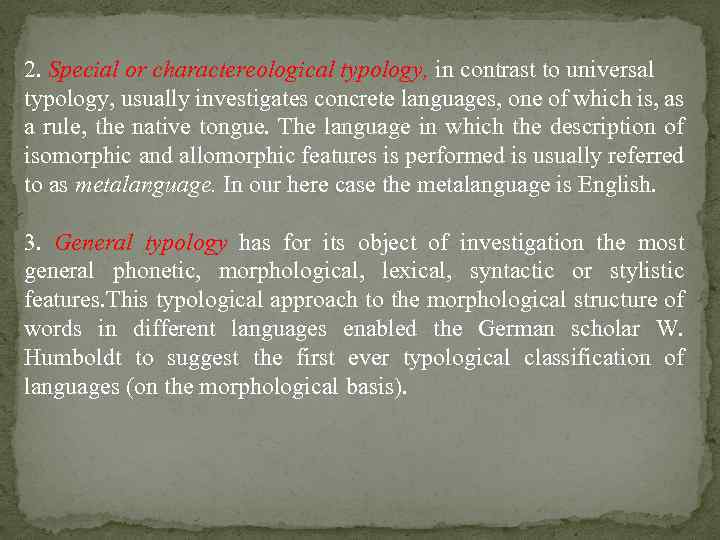 2. Special or charactereological typology, in contrast to universal typology, usually investigates concrete languages, one of which is, as a rule, the native tongue. The language in which the description of isomorphic and allomorphic features is performed is usually referred to as metalanguage. In our here case the metalanguage is English. 3. General typology has for its object of investigation the most general phonetic, morphological, lexical, syntactic or stylistic features. This typological approach to the morphological structure of words in different languages enabled the German scholar W. Humboldt to suggest the first ever typological classification of languages (on the morphological basis).
2. Special or charactereological typology, in contrast to universal typology, usually investigates concrete languages, one of which is, as a rule, the native tongue. The language in which the description of isomorphic and allomorphic features is performed is usually referred to as metalanguage. In our here case the metalanguage is English. 3. General typology has for its object of investigation the most general phonetic, morphological, lexical, syntactic or stylistic features. This typological approach to the morphological structure of words in different languages enabled the German scholar W. Humboldt to suggest the first ever typological classification of languages (on the morphological basis).
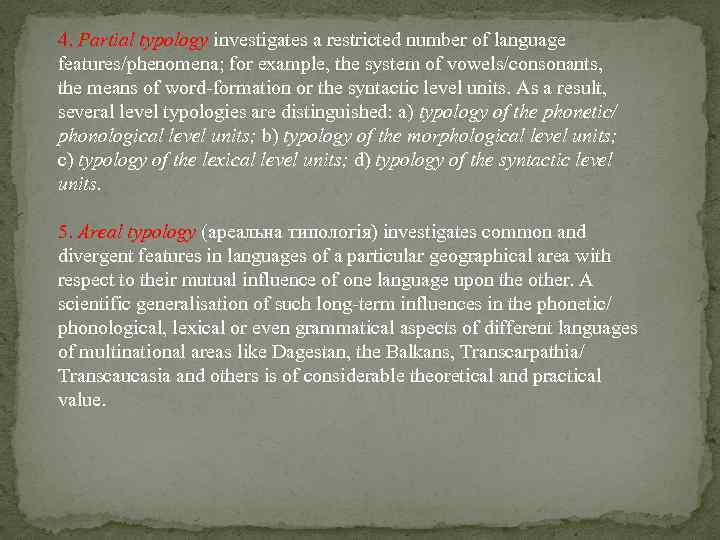 4. Partial typology investigates a restricted number of language features/phenomena; for example, the system of vowels/consonants, the means of word-formation or the syntactic level units. As a result, several level typologies are distinguished: a) typology of the phonetic/ phonological level units; b) typology of the morphological level units; c) typology of the lexical level units; d) typology of the syntactic level units. 5. Areal typology (ареальна типологія) investigates common and divergent features in languages of a particular geographical area with respect to their mutual influence of one language upon the other. A scientific generalisation of such long-term influences in the phonetic/ phonological, lexical or even grammatical aspects of different languages of multinational areas like Dagestan, the Balkans, Transcarpathia/ Transcaucasia and others is of considerable theoretical and practical value.
4. Partial typology investigates a restricted number of language features/phenomena; for example, the system of vowels/consonants, the means of word-formation or the syntactic level units. As a result, several level typologies are distinguished: a) typology of the phonetic/ phonological level units; b) typology of the morphological level units; c) typology of the lexical level units; d) typology of the syntactic level units. 5. Areal typology (ареальна типологія) investigates common and divergent features in languages of a particular geographical area with respect to their mutual influence of one language upon the other. A scientific generalisation of such long-term influences in the phonetic/ phonological, lexical or even grammatical aspects of different languages of multinational areas like Dagestan, the Balkans, Transcarpathia/ Transcaucasia and others is of considerable theoretical and practical value.
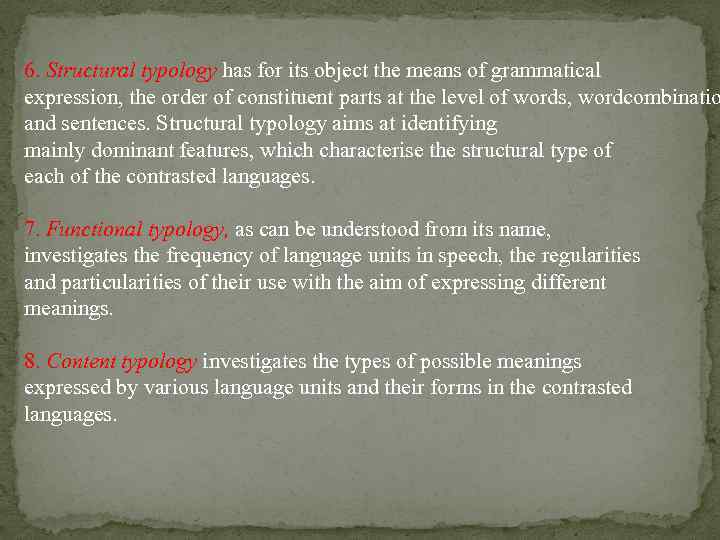 6. Structural typology has for its object the means of grammatical expression, the order of constituent parts at the level of words, wordcombinatio and sentences. Structural typology aims at identifying mainly dominant features, which characterise the structural type of each of the contrasted languages. 7. Functional typology, as can be understood from its name, investigates the frequency of language units in speech, the regularities and particularities of their use with the aim of expressing different meanings. 8. Content typology investigates the types of possible meanings expressed by various language units and their forms in the contrasted languages.
6. Structural typology has for its object the means of grammatical expression, the order of constituent parts at the level of words, wordcombinatio and sentences. Structural typology aims at identifying mainly dominant features, which characterise the structural type of each of the contrasted languages. 7. Functional typology, as can be understood from its name, investigates the frequency of language units in speech, the regularities and particularities of their use with the aim of expressing different meanings. 8. Content typology investigates the types of possible meanings expressed by various language units and their forms in the contrasted languages.
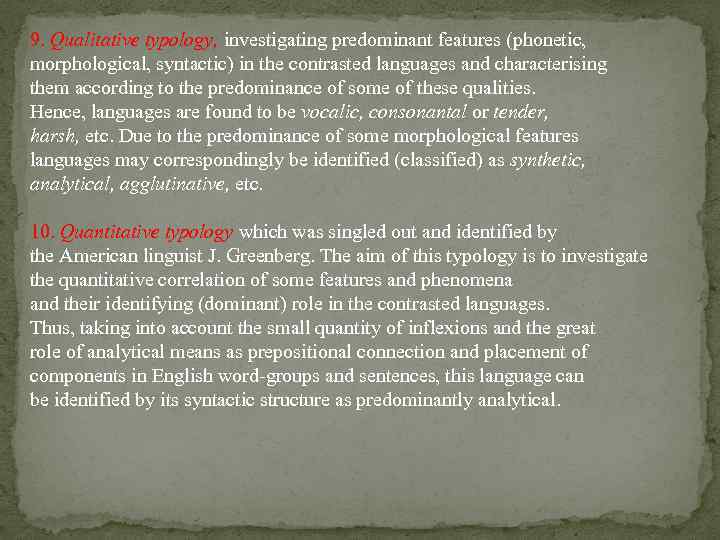 9. Qualitative typology, investigating predominant features (phonetic, morphological, syntactic) in the contrasted languages and characterising them according to the predominance of some of these qualities. Hence, languages are found to be vocalic, consonantal or tender, harsh, etc. Due to the predominance of some morphological features languages may correspondingly be identified (classified) as synthetic, analytical, agglutinative, etc. 10. Quantitative typology which was singled out and identified by the American linguist J. Greenberg. The aim of this typology is to investigate the quantitative correlation of some features and phenomena and their identifying (dominant) role in the contrasted languages. Thus, taking into account the small quantity of inflexions and the great role of analytical means as prepositional connection and placement of components in English word-groups and sentences, this language can be identified by its syntactic structure as predominantly analytical.
9. Qualitative typology, investigating predominant features (phonetic, morphological, syntactic) in the contrasted languages and characterising them according to the predominance of some of these qualities. Hence, languages are found to be vocalic, consonantal or tender, harsh, etc. Due to the predominance of some morphological features languages may correspondingly be identified (classified) as synthetic, analytical, agglutinative, etc. 10. Quantitative typology which was singled out and identified by the American linguist J. Greenberg. The aim of this typology is to investigate the quantitative correlation of some features and phenomena and their identifying (dominant) role in the contrasted languages. Thus, taking into account the small quantity of inflexions and the great role of analytical means as prepositional connection and placement of components in English word-groups and sentences, this language can be identified by its syntactic structure as predominantly analytical.
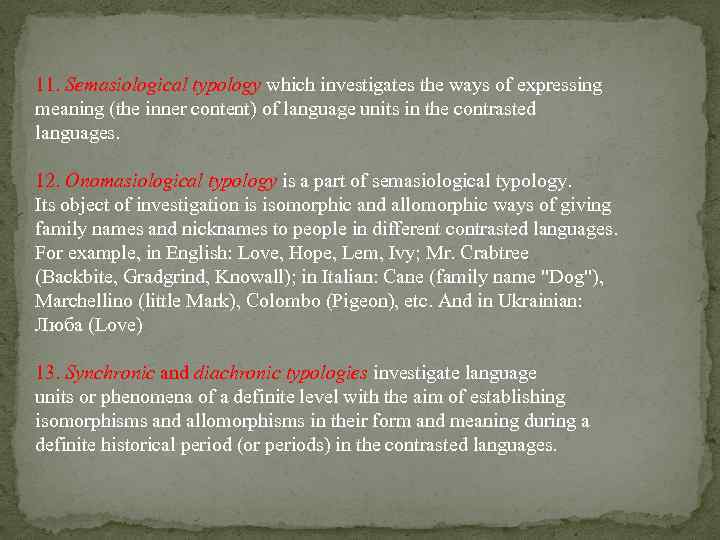 11. Semasiological typology which investigates the ways of expressing meaning (the inner content) of language units in the contrasted languages. 12. Onomasiological typology is a part of semasiological typology. Its object of investigation is isomorphic and allomorphic ways of giving family names and nicknames to people in different contrasted languages. For example, in English: Love, Hope, Lem, Ivy; Mr. Crabtree (Backbite, Gradgrind, Knowall); in Italian: Cane (family name "Dog"), Marchellino (little Mark), Colombo (Pigeon), etc. And in Ukrainian: Люба (Love) 13. Synchronic and diachronic typologies investigate language units or phenomena of a definite level with the aim of establishing isomorphisms and allomorphisms in their form and meaning during a definite historical period (or periods) in the contrasted languages.
11. Semasiological typology which investigates the ways of expressing meaning (the inner content) of language units in the contrasted languages. 12. Onomasiological typology is a part of semasiological typology. Its object of investigation is isomorphic and allomorphic ways of giving family names and nicknames to people in different contrasted languages. For example, in English: Love, Hope, Lem, Ivy; Mr. Crabtree (Backbite, Gradgrind, Knowall); in Italian: Cane (family name "Dog"), Marchellino (little Mark), Colombo (Pigeon), etc. And in Ukrainian: Люба (Love) 13. Synchronic and diachronic typologies investigate language units or phenomena of a definite level with the aim of establishing isomorphisms and allomorphisms in their form and meaning during a definite historical period (or periods) in the contrasted languages.
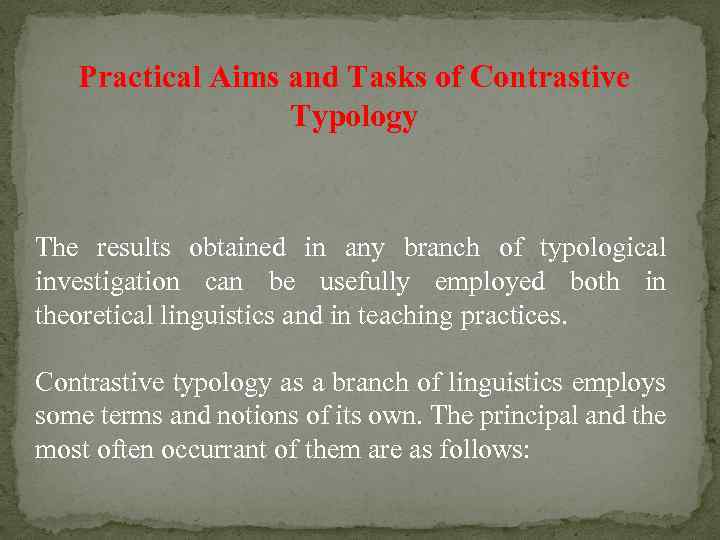 Practical Aims and Tasks of Contrastive Typology The results obtained in any branch of typological investigation can be usefully employed both in theoretical linguistics and in teaching practices. Contrastive typology as a branch of linguistics employs some terms and notions of its own. The principal and the most often occurrant of them are as follows:
Practical Aims and Tasks of Contrastive Typology The results obtained in any branch of typological investigation can be usefully employed both in theoretical linguistics and in teaching practices. Contrastive typology as a branch of linguistics employs some terms and notions of its own. The principal and the most often occurrant of them are as follows:
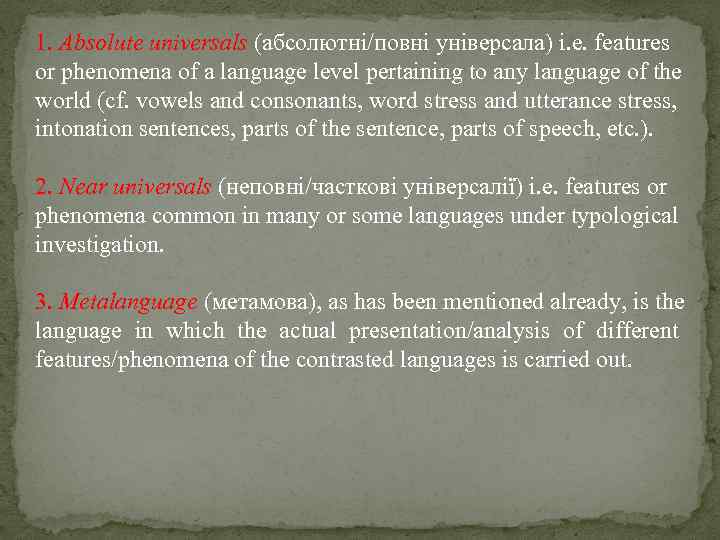 1. Absolute universals (абсолютні/повні універсала) i. e. features or phenomena of a language level pertaining to any language of the world (cf. vowels and consonants, word stress and utterance stress, intonation sentences, parts of the sentence, parts of speech, etc. ). 2. Near universals (неповні/часткові універсалії) i. e. features or phenomena common in many or some languages under typological investigation. 3. Metalanguage (метамова), as has been mentioned already, is the language in which the actual presentation/analysis of different features/phenomena of the contrasted languages is carried out.
1. Absolute universals (абсолютні/повні універсала) i. e. features or phenomena of a language level pertaining to any language of the world (cf. vowels and consonants, word stress and utterance stress, intonation sentences, parts of the sentence, parts of speech, etc. ). 2. Near universals (неповні/часткові універсалії) i. e. features or phenomena common in many or some languages under typological investigation. 3. Metalanguage (метамова), as has been mentioned already, is the language in which the actual presentation/analysis of different features/phenomena of the contrasted languages is carried out.
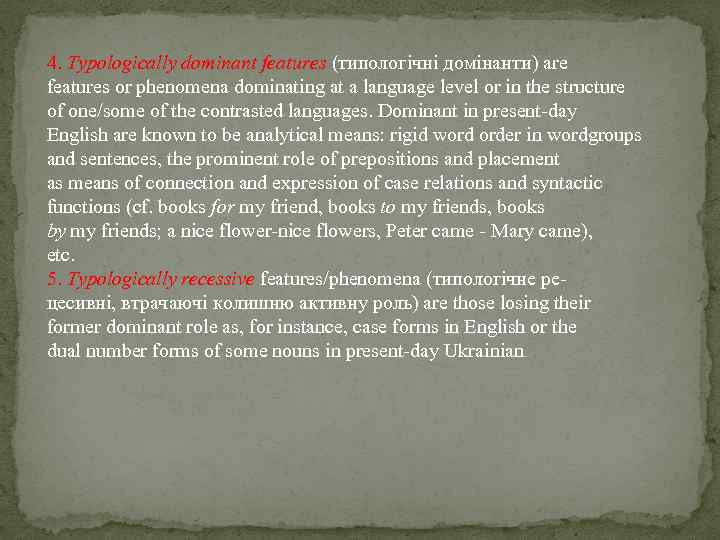 4. Typologically dominant features (типологічні домінанти) are features or phenomena dominating at a language level or in the structure of one/some of the contrasted languages. Dominant in present-day English are known to be analytical means: rigid word order in wordgroups and sentences, the prominent role of prepositions and placement as means of connection and expression of case relations and syntactic functions (cf. books for my friend, books to my friends, books by my friends; a nice flower-nice flowers, Peter came - Mary came), etc. 5. Typologically recessive features/phenomena (типологічне рецесивні, втрачаючі колишню активну роль) are those losing their former dominant role as, for instance, case forms in English or the dual number forms of some nouns in present-day Ukrainian.
4. Typologically dominant features (типологічні домінанти) are features or phenomena dominating at a language level or in the structure of one/some of the contrasted languages. Dominant in present-day English are known to be analytical means: rigid word order in wordgroups and sentences, the prominent role of prepositions and placement as means of connection and expression of case relations and syntactic functions (cf. books for my friend, books to my friends, books by my friends; a nice flower-nice flowers, Peter came - Mary came), etc. 5. Typologically recessive features/phenomena (типологічне рецесивні, втрачаючі колишню активну роль) are those losing their former dominant role as, for instance, case forms in English or the dual number forms of some nouns in present-day Ukrainian.
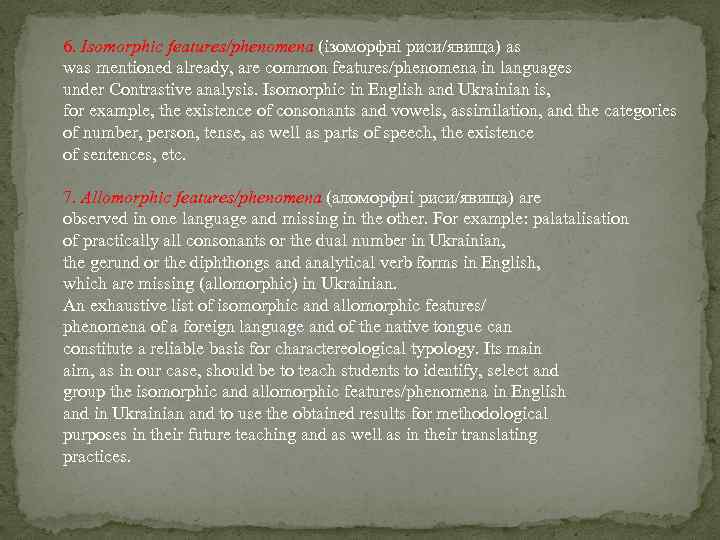 6. Isomorphic features/phenomena (ізоморфні риси/явища) as was mentioned already, are common features/phenomena in languages under Contrastive analysis. Isomorphic in English and Ukrainian is, for example, the existence of consonants and vowels, assimilation, and the categories of number, person, tense, as well as parts of speech, the existence of sentences, etc. 7. Allomorphic features/phenomena (аломорфні риси/явища) are observed in one language and missing in the other. For example: palatalisation of practically all consonants or the dual number in Ukrainian, the gerund or the diphthongs and analytical verb forms in English, which are missing (allomorphic) in Ukrainian. An exhaustive list of isomorphic and allomorphic features/ phenomena of a foreign language and of the native tongue can constitute a reliable basis for charactereological typology. Its main aim, as in our case, should be to teach students to identify, select and group the isomorphic and allomorphic features/phenomena in English and in Ukrainian and to use the obtained results for methodological purposes in their future teaching and as well as in their translating practices.
6. Isomorphic features/phenomena (ізоморфні риси/явища) as was mentioned already, are common features/phenomena in languages under Contrastive analysis. Isomorphic in English and Ukrainian is, for example, the existence of consonants and vowels, assimilation, and the categories of number, person, tense, as well as parts of speech, the existence of sentences, etc. 7. Allomorphic features/phenomena (аломорфні риси/явища) are observed in one language and missing in the other. For example: palatalisation of practically all consonants or the dual number in Ukrainian, the gerund or the diphthongs and analytical verb forms in English, which are missing (allomorphic) in Ukrainian. An exhaustive list of isomorphic and allomorphic features/ phenomena of a foreign language and of the native tongue can constitute a reliable basis for charactereological typology. Its main aim, as in our case, should be to teach students to identify, select and group the isomorphic and allomorphic features/phenomena in English and in Ukrainian and to use the obtained results for methodological purposes in their future teaching and as well as in their translating practices.
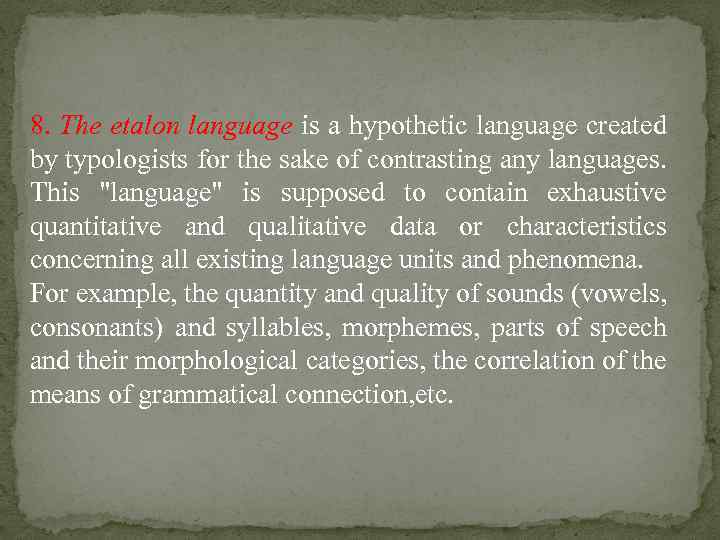 8. The etalon language is a hypothetic language created by typologists for the sake of contrasting any languages. This "language" is supposed to contain exhaustive quantitative and qualitative data or characteristics concerning all existing language units and phenomena. For example, the quantity and quality of sounds (vowels, consonants) and syllables, morphemes, parts of speech and their morphological categories, the correlation of the means of grammatical connection, etc.
8. The etalon language is a hypothetic language created by typologists for the sake of contrasting any languages. This "language" is supposed to contain exhaustive quantitative and qualitative data or characteristics concerning all existing language units and phenomena. For example, the quantity and quality of sounds (vowels, consonants) and syllables, morphemes, parts of speech and their morphological categories, the correlation of the means of grammatical connection, etc.
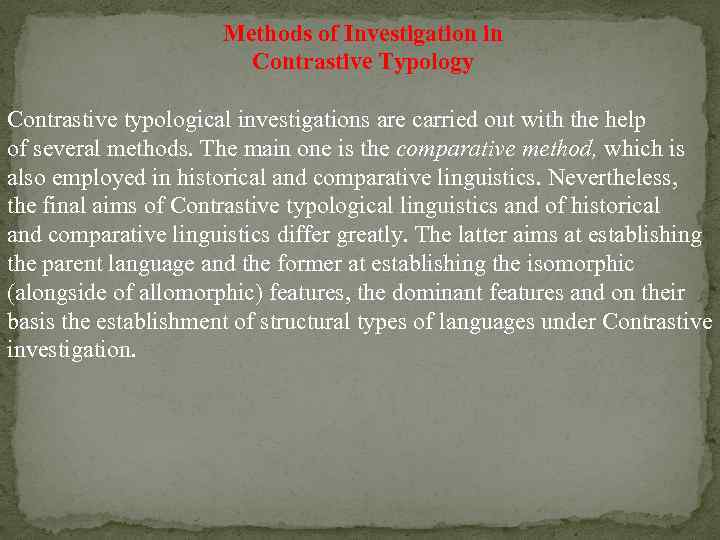 Methods of Investigation in Contrastive Typology Contrastive typological investigations are carried out with the help of several methods. The main one is the comparative method, which is also employed in historical and comparative linguistics. Nevertheless, the final aims of Contrastive typological linguistics and of historical and comparative linguistics differ greatly. The latter aims at establishing the parent language and the former at establishing the isomorphic (alongside of allomorphic) features, the dominant features and on their basis the establishment of structural types of languages under Contrastive investigation.
Methods of Investigation in Contrastive Typology Contrastive typological investigations are carried out with the help of several methods. The main one is the comparative method, which is also employed in historical and comparative linguistics. Nevertheless, the final aims of Contrastive typological linguistics and of historical and comparative linguistics differ greatly. The latter aims at establishing the parent language and the former at establishing the isomorphic (alongside of allomorphic) features, the dominant features and on their basis the establishment of structural types of languages under Contrastive investigation.
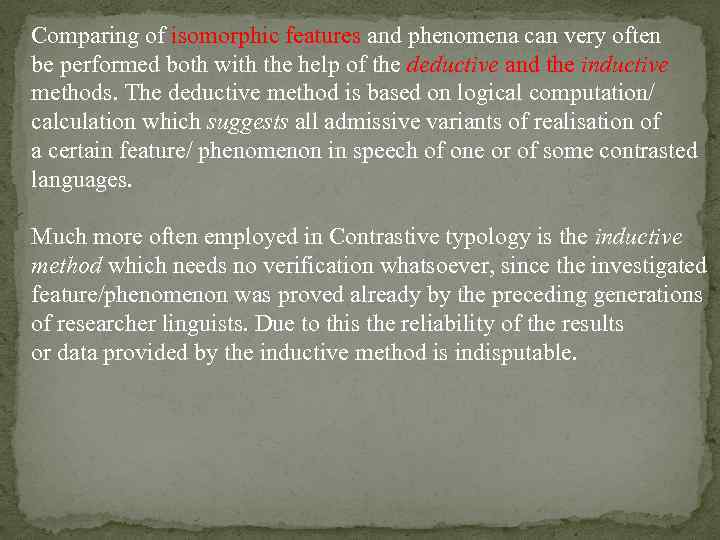 Comparing of isomorphic features and phenomena can very often be performed both with the help of the deductive and the inductive methods. The deductive method is based on logical computation/ calculation which suggests all admissive variants of realisation of a certain feature/ phenomenon in speech of one or of some contrasted languages. Much more often employed in Contrastive typology is the inductive method which needs no verification whatsoever, since the investigated feature/phenomenon was proved already by the preceding generations of researcher linguists. Due to this the reliability of the results or data provided by the inductive method is indisputable.
Comparing of isomorphic features and phenomena can very often be performed both with the help of the deductive and the inductive methods. The deductive method is based on logical computation/ calculation which suggests all admissive variants of realisation of a certain feature/ phenomenon in speech of one or of some contrasted languages. Much more often employed in Contrastive typology is the inductive method which needs no verification whatsoever, since the investigated feature/phenomenon was proved already by the preceding generations of researcher linguists. Due to this the reliability of the results or data provided by the inductive method is indisputable.
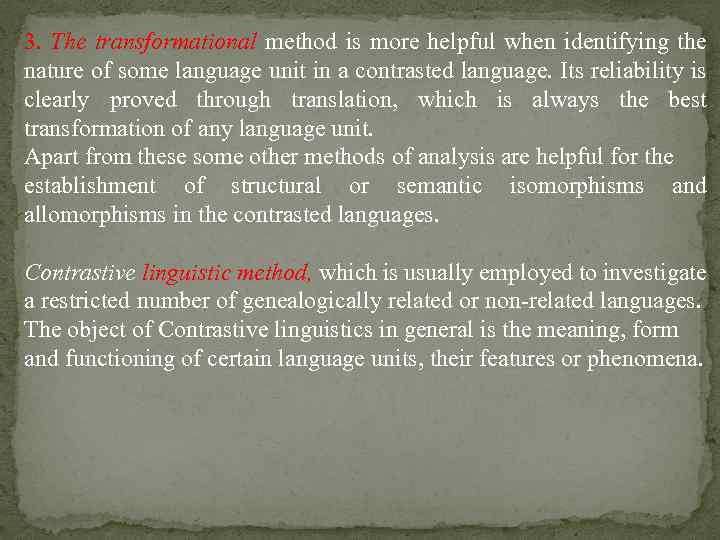 3. The transformational method is more helpful when identifying the nature of some language unit in a contrasted language. Its reliability is clearly proved through translation, which is always the best transformation of any language unit. Apart from these some other methods of analysis are helpful for the establishment of structural or semantic isomorphisms and allomorphisms in the contrasted languages. Contrastive linguistic method, which is usually employed to investigate a restricted number of genealogically related or non-related languages. The object of Contrastive linguistics in general is the meaning, form and functioning of certain language units, their features or phenomena.
3. The transformational method is more helpful when identifying the nature of some language unit in a contrasted language. Its reliability is clearly proved through translation, which is always the best transformation of any language unit. Apart from these some other methods of analysis are helpful for the establishment of structural or semantic isomorphisms and allomorphisms in the contrasted languages. Contrastive linguistic method, which is usually employed to investigate a restricted number of genealogically related or non-related languages. The object of Contrastive linguistics in general is the meaning, form and functioning of certain language units, their features or phenomena.


